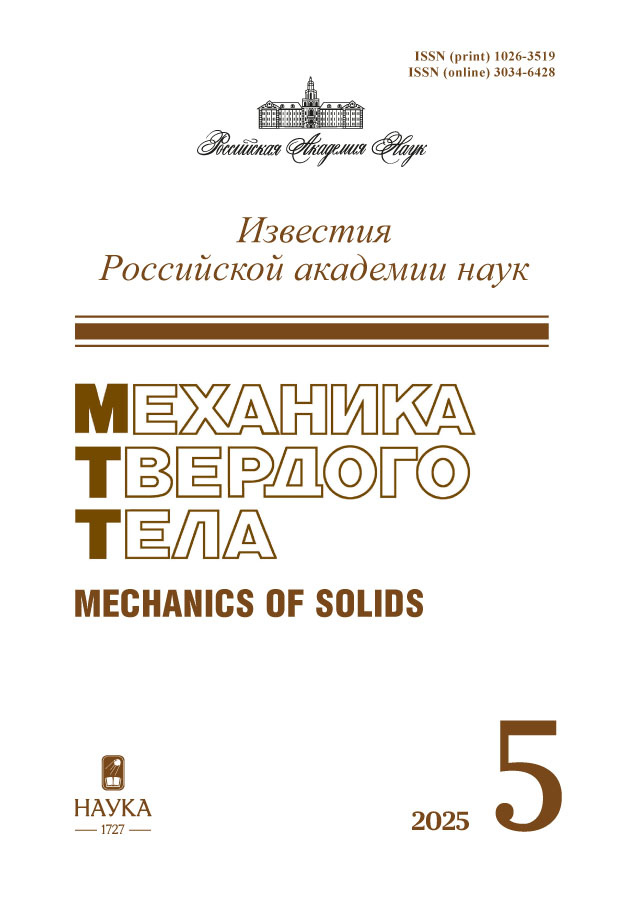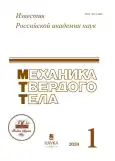Моделирование динамики экзоскелета системой трех звеньев переменной длины с регулируемой жесткостью
- Авторы: Блинов А.О.1, Борисов А.В.1, Мухарлямов Р.Г.2, Новикова М.А.1
-
Учреждения:
- Филиал ФГБОУ ВО НИУ “МЭИ” в г. Смоленске
- Институт физических исследований и технологий ФГАОУ ВО Российский университет дружбы народов
- Выпуск: № 1 (2024)
- Страницы: 268-284
- Раздел: Статьи
- URL: https://gynecology.orscience.ru/1026-3519/article/view/673142
- DOI: https://doi.org/10.31857/S1026351924010158
- EDN: https://elibrary.ru/VZJQFU
- ID: 673142
Цитировать
Полный текст
Аннотация
В статье предложена пространственная модель экзоскелета для опорно-двигательного аппарата человека, представленная тремя подвижными звеньями переменной длины и двумя точечными массами. Управление жесткостью звеньев осуществляется изменением напряжения, подаваемого на магнитно-реологическую жидкость, заполняющую участки переменной длины. Модель можно использовать для разработки комфортабельных экзоскелетов, кинематические характеристики которых близких к кинематическим характеристикам опорно-двигательного аппарата человека. Уравнения динамики модели составляются с использованием локальных систем координат.
Требуемые законы изменения обобщенных координат задаются уравнениями программных связей, определяющих зависимость дифференцируемых периодических функций от времени. Управляющие моменты и продольные силы определяются методами решения обратных задач динамики и реализуются изменением напряженностей магнитных полей, влияющих на изменение жесткости магнитно-реологической жидкости. Управляющие жесткостью звена напряженности магнитных полей реализуются ступенчатыми функциями. Синтезирована анимация движения механизма, показывающая адекватность предложенной процедуры моделирования. Соединения звеньев моделируются шарнирами и двигателями, реализующими необходимое вращательное движение. Управление динамикой модели осуществляется изменением длин звеньев и углов между звеньями.
Полный текст
Об авторах
А. О. Блинов
Филиал ФГБОУ ВО НИУ “МЭИ” в г. Смоленске
Автор, ответственный за переписку.
Email: alex-blinov67@yandex.ru
Россия, Смоленск
А. В. Борисов
Филиал ФГБОУ ВО НИУ “МЭИ” в г. Смоленске
Email: borisowandrej@yandex.ru
Россия, Смоленск
Р. Г. Мухарлямов
Институт физических исследований и технологий ФГАОУ ВО Российский университет дружбы народов
Email: robgar@mail.ru
Россия, Москва
М. А. Новикова
Филиал ФГБОУ ВО НИУ “МЭИ” в г. Смоленске
Email: mar.novikova@ro.ru
Россия, Смоленск
Список литературы
- Борисов А.В., Каспирович И.Е., Мухарлямов Р.Г. О математическом моделировании динамики многозвенных систем и экзоскелетов // Известия РАН. Теория и системы управления. 2021. № 5. С. 162–176. https://doi.org/10.31857/S0002338821040028
- Borisov A.V., Chigarev A.V. The causes of a change in the length of a person’s link and their consideration when creating an exoskeleton // Biomed. J. Sci. Tech. Res. 2020. V. 25. Р. 18769–18771. https://doi.org/10.26717/BJSTR.2020.25.004137
- Piña-Martínez E., Rodriguez-Leal E. Inverse modeling of human knee joint based on geometry and vision systems for exoskeleton applications // Math. Probl. Eng. 2015. V. 2015. P. 145734. http://dx.doi.org/10.1155/2015/145734
- Nordin M., Frankel H. Basic biomechanics of the musculoskeletal system. Lippicot–London: Williams & Wilkins, 2001. 467 р.
- Borisov A.V., Chigarev A.V. Mathematical models of exoskeleton. Dynamics, strength, control. Springer, 2022. 232 р. https://doi.org/10.1007/978-3-030-97733-7
- Борисов А.В., Каспирович И.Е., Мухарлямов Р.Г., Филиппенков К.Д. Роботизированная управляемая электромеханическая модель двух звеньев переменной длины аэрокосмического назначения // Известия ВУЗов. Авиационная техника. 2022. № 1. С. 60–69.
- Борисов А.В., Каспирович И.Е., Мухарлямов Р.Г. Управление динамикой составной конструкции со звеньями переменной длины // Изв. РАН. МТТ. 2021. № 2. С. 72–87. https://doi.org/10.31857/S0572329921020057
- Blinov A., Borisov A., Konchina L., Kulikova M., Maslova K. Simulation of the movement of the supporting leg of an exoskeleton with two links of variable length in 3D // J. Appl. Informatics. 2021. V. 16. № 4. P. 122–134. https://doi.org/10.37791/2687-0649-2021-16-4-122-134
- Blinov A., Borisov A., Filippenkov K., Konchina L., Maslova K. Modeling the dynamics of an exoskeleton link of variable length using the Lagrange – Maxwell system of differential equations of motion // J. Appl. Informatics. 2022. V. 17. № 3. P. 117–130. https://doi.org/10.37791/2687-0649-2022-17-3-117-130
- Franks P.W., Bryan G.M., Martin R.M., Reyes R., Lakmazaheri A.C., Collins S.H. Comparing optimized exoskeleton assistance of the hip, knee, and ankle in single and multi-joint configurations // Wearable Technologies. 2021. V. 2. e16. https://doi.org/10.1017/wtc.2021.14
- Das Gupta S., Bobbert M.F. and Kistemaker D.A. The metabolic cost of walking in healthy young and older adults – A systematic review and meta analysis // Sci. Rep. 2019. V. 9. P. 9956. https://doi.org/10.1038/s41598-019-45602-4
- Sanchez N., Simha S.N., Donelan J.M. and Finley J.M. Using asymmetry to your advantage: Learning to acquire and accept external assistance during prolonged split-belt walking // J. Neurophysiol. 2020. V. 125. № 2. Р. 344–357. https://doi.org/10.1152/jn.00416.2020
- Young A.J. and Ferris D.P. State of the art and future directions for lower limb robotic exoskeletons // IEEE Trans. Neural Syst. Rehabil. Eng. 2017. V. 25. № 2. Р. 171–182. https://doi.org/10.1109/TNSRE.2016.2521160
- Sawicki G.S., Beck O.N., Kang I. and Young A.J. The exoskeleton expansion: Improving walking and running economy // J. Neuroeng. Rehabilitation. 2020. V. 17. P. 25. https://doi.org/10.1186/s12984-020-00663-9
- Ding Y., Kim M., Kuindersma S., Walsh C.J. Human-in-the-loop optimization of hip assistance with a soft exosuit during walking // Sci. Robot. 2018. V. 3. № 15. P.5438. https://doi.org/10.1126/scirobotics.aar5438
- Lee S., Kim J., Baker L., Long A., Karavas N., Menard N., Galiana I., Walsh C.J. Autonomous multi-joint soft exosuit with augmentation-power-based control parameter tuning reduces energy cost of loaded walking // J. Neuroeng. Rehabilitation. 2018. V. 15. P. 66. https://doi.org/10.1186/s12984-018-0410-y
- Malcolm P., Galle S., Derave Wand De Clercq D. Bi-articular knee-ankle-foot exoskeleton produces higher metabolic cost reduction than weight-matched mono-articular exoskeleton // Front. Neurosci. 2018. V. 12. P. 69. https://doi.org/10.3389/fnins.2018.00069
- Lim B., Lee J., Jang J., Kim K., Park Y.J., Seo K., Shim Y. Delayed output feedback control for gait assistance with a robotic hip exoskeleton // IEEE Trans. Robot. 2019. V. 35. № 4. Р. 1055–1062. https://doi.org/10.1109/TRO.2019.2913318
- MacLean M.K. and Ferris D.P. Energetics of walking with a robotic knee exoskeleton // J. Appl. Biomech. 2019. V. 35. № 5. Р. 320–326. https://doi.org/10.1123/jab.2018-0384
- Cao W., Chen C., Hu H., Fang K., Wu X. Effect of hip assistance modes on metabolic cost of walking with a soft exoskeleton // IEEE Trans. Autom. Sci. Eng. 2020. V. 18. № 2. Р. 426–436. https://doi.org/10.1109/TASE.2020.3027748
- Medrano R.L., Thomas G.C., Rouse E.J. Methods for measuring the just noticeable difference for variable stimuli: Implications for perception of metabolic rate with exoskeleton assistance // 8th IEEE RAS/EMBS International Conference for Biomedical Robotics and Biomechatronics (BioRob). NY.: IEEE. 2020. P. 483–490. https://doi.org/10.1109/BioRob49111.2020.9224374
- Franks P.W., Bianco N.A., Bryan G.M., Hicks J.L., Delp S.L., Collins S.H. Testing simulated assistance strategies on a hipknee-ankle exoskeleton: A case study // 8th IEEE RAS/EMBS International Conference for Biomedical Robotics and Biomechatronics (BioRob). NY.: IEEE. 2020. P. 700–707. https://doi.org/10.1109/BioRob49111.2020.9224345
- Bryan G.M., Franks P.W., Klein S.C., Peuchen R.J., Collins S.H. A hip–knee–ankle exoskeleton emulator for studying gait assistance // Int. J. Robot. Res. 2020. V. 40. № 4–5. Р. 722–746. https://doi.org/10.1177/0278364920961452
- Bengler K., Harbauer C.M., Fleischer M. Exoskeletons: A challenge for development // Wearable Tech. 2023. V. 4. e1. https://doi.org/10.1017/wtc.2022.28
- Carlson J. Magnetorheological Fluid Actuators // Adaptronics and Smart Structures: Basics, Materials, Design, and Applications. Saarbrücken: Springer, 1999. Р. 180–195.
- Laflamme S. Online learning algorithm for structural control using magnetorheological actuators. Massachusetts institute of technology, 2007. 88 р.
- Ahmadkhanlou F., Zite J.L., Washington G.N. A magnetorheological fluid-based controllable active knee brace // Proc. SPIE. 2007. V. 6527. Р. 652700. https://doi.org/10.1117/12.715902
- Chen J., Liao W. Design, testing and control of a magnetorheological actuator for assistive knee braces // Smart Mater. Struct. 2010. V. 19. № 2. Р. 035029. https://doi.org/10.1088/0964-1726/19/3/035029
- Bougrinat Y. Design and development of a lightweight ankle exoskeleton for human walking augmentation // Mechatronics. 2019. V. 64. P. 102297. https://doi.org/10.1016/j.mechatronics.2019.102297
- Blinov A., Borisov A., Konchina L., Novikova M. Applying the models of magneto- rheological substances in the study of exoskeleton variable-length link with adjustable stiffness // J. Appl. Inform. 2022. V. 17. № 2. P. 133-142. https://doi.org/10.37791/2687-0649-2022-17-2-133-142
- Седов Л.И. Механика сплошной среды. Т. 1. М. Наука, 1970. 492 с.
- Покровский В.Н. Статистическая механика разбавленных суспензий. М.: Наука, 1978. 136 с.
- Лахтина Е.В., Пшеничников А.Ф. Дисперсия магнитной восприимчивости и микроструктура магнитной жидкости // Коллоидный журнал. 2006. Т. 68. № 3. С. 327–337.
- Коновалова Н.И., Мартынов С.И. Динамика магнитных частиц в вязкой жидкости // Изв. вузов. Поволжский регион. Физико-математические науки. 2009. № 3. С. 3–11.
- Чириков Д.Н. Вязкоупругие свойства магнитных жидкостей. Дисс. канд. физ.-мат. наук. Екатеринбург, 2012. 102 с.
- Jason P. Rich, Patrick S. Doyle, Gareth H. McKinley Magnetorheology in an aging, yield stress matrix fluid // Rheol. Acta. 2012. V. 51. P. 579–593. https://doi.org/10.1007/s00397-012-0632-z
- Чириков Д.Н. Теоретическое исследование реологических свойств бидисперсных магнитных жидкостей: заключительный отчет о НИР. Екатеринбург, 2013. 17 с.
- Новопашин С.А., Серебрякова М.А., Хмель С.Я. Методы синтеза магнитных жидкостей // Теплофизика и аэромеханика. 2015. Т. 22. № 4. С. 411–427.
- Lebedev A.V. Viscosity of magnetic fluids must be modified in calculations of dynamic susceptibility // J. Magn. Magn. Mater. 2017. V. 431. Р. 30-32. https://doi.org/10.1016/j.jmmm.2016.09.110
- Магнитореологические жидкости: технологии создания и применение: монография / Е.С. Беляев и др. под ред. А.С. Плехова. Ниж. Новгород.: Нижегородский гос. техн. ун-т им. Р.Е. Алексеева, 2017. 94 с.
- Alekhina Y.A., Makarova L.A., Rusakova T.S., Semisalova A.S., Perov N.S. Properties of magnetorheological elastomers in crossed AC and DC magnetic fields // Журнал Сибирского федерального университет. Серия: Математика и физика. 2017 Т. 10. № 1. С. 45–50. https://doi.org/10.17516/1997-1397-2017-10-1-45-50
- Пучков П.В. О применении магнитных жидкостей в качестве смазочного материала в узлах трения машин и механизмов // Технические науки. 2018. Т. 1. № 78. С. 95-99.
- Макарова Л.А. Исследование магнитных и электрических свойств композитных реологических материалов на основе ферромагнитных и сегнетоэлектрических наполнителей. Дисс. канд. физ.-мат. наук, МГУ. 2018. 182 с.
- Юсупбеков Х.А., Собиров М.М., Юлдашев А.Р. Активные подвески автомобиля с амортизаторами переменной жесткости // Наука, техника и образование. 2020. № 2(66). С. 18–27.
- Найгерт К.В., Целищев В.А. Прикладные свойства магнитореологических жидкостей. Уфа.: УГАТУ, 2021. 118 с.
- Черноусько Ф.Л., Ананьевский И.М., Решмин С.А. Методы управления нелинейными механическими системами. М.: Физматлит, 2006. 328 с.
- Борисов А.В. Моделирование опорно-двигательного аппарата человека и применение полученных результатов для разработки модели антропоморфного робота. М.: Спутник +, 2009. 212 с.
Дополнительные файлы
















